Don't wanna be here? Send us removal request.
Text
A Ghost Town Of My Own

RAMBLER MAN - While this isn’t the Rambler which belonged to my family, it’s nearly identical to one which my parents owned when I was in high school. Easily a quarter of my childhood was spent in the backseat (or lying across a monstrous ice cooler in the back window) of a wide variety of different models of station wagons.
For one month every summer during my childhood, my father would temporarily forget that he was the head of a perfectly ordinary suburban-living family. In early July he’d randomly open up a road map, pick a highway he’d never been down or a place he’d never visited, and then he’d announce to the rest of us where we’d be heading for our summer vacation. Often we wouldn’t have even that much notice. I can remember at least one occasion on which I was awakened shortly before dawn, told to pack, and that we’d be leaving in half an hour for the Deep South -- not a particular state or a city mind you, just the Deep South. As far as I can tell, with other families this would have been sheer madness, but for us it was just part and parcel of being a Hallford. My father wasn’t big on elaborate plans, but preferred instead to follow his nose wherever it lead him. As you might imagine, we ended up on quite a few unintended adventures along the way.
Riding in the back of the family station wagon (of which my family had three over the years), I saw a lot of the United States. Dad liked to get off the main roads whenever he could, and we spent a lot of time bumping around on state highways that had fallen into disrepair, or uppity cow paths that only dreamed someday of being called roads. In particular we found ourselves frequently being drawn to Civil War battlefields which were a passion for my father, and which became a fascination of my own as I grew older. Dad shunned the big cities and glitzy attractions, instead favoring broken down old towns, fading glories, and greasy spoon diners. Never in all my life did I ever see him ever crack open a book on history, but instead I think this was his own Aristotelian way of exploring the past, through direct contact with people and places that made up our country. I think he was trying to trying to find something that was on the verge of vanishing, though to be honest, to this day I’m still not sure if he ever found what he was looking for. Regardless of that, we all enjoyed the ride.
One thing in particular that became a hobby of mine over the years was to spend time in the filling stations of tiny towns in the middle of nowhere. Inevitably they always had the coolest stuff on the shelves that you couldn’t find anywhere else. Jackalope heads. Bigfoot castings. Sometimes you’d get lucky and they’d have a tiny little museum with mermaid skeletons or two-headed calves or little carved aliens. I loved the sheer humbuggery and imagination of all the roadside attractions. Sometimes you could get a bored station attendant to tell you a ghost story while you paid your bill, or even better, they’d sell you a stapled-together collection of local folktales (usually written by the station owner himself.) In time the discovery of these roadside spook stories became an integral part of my enjoyment of our vacations.
By the time I hit high school and the family vacations had come to an end, I’d become increasingly interested not only in the stories from these small towns, but also in stories which I’d heard whispered in passing by my father’s family, most of them involving the Hallford homestead. There were stories about my Uncle Owen and his new bride being haunted by ghostly horses on their wedding night. My grandmother claimed to have clearly seen her dead mother walking through the field of her house, and also found herself trying to pick up a ghost cat that wasn’t there. A nearby house of another family member reputedly had doors that could not be locked or nailed shut, and even my deeply fundamentalist, God-fearing mother has told me tales of spending the night in that house, witnessing doors opening and slamming on their own accord while accompanied by the sound of a child’s footsteps.
While collecting these family ghost stories was a fun pastime for me, I kind of felt like the ghost parade had passed me by. The Hallford homestead had burned down years before I’d even been born, and the property on which it sat was a place that I rarely visited. Even my uncle who owned the property for most of my young adulthood preferred to leave it unoccupied, and refused to let anyone rebuild on the site of “that house.” For years I vowed to sneak out and spend the night on top of the hill where the house once stood, but circumstances always seemed to conspire to prevent me from doing so. On my last encounter in that field, an angry bull almost trampled me while I was inspecting what little remained of the chimney.
In order to find some spooks to claim as my own, I turned my focus on my hometown of Sand Springs, Oklahoma, a bedroom community just seven miles west of Tulsa. In my neighborhood, we had our own version of the boogeyman known as the Bulldog Man (upon whom my first radio drama would be based). Kids at my local high school told stories about “Mr. Green” who was killed during the construction of the auditorium, and who to this day is still said to haunt the thespians of Charles Page High School. Another friend claimed to have been in a trailer by the lake when it was attacked by a creature that he described as something like a werewolf.
Clearly there were stories to be found in Sand Springs, so naturally I decided to seek out a chapbook similar to those I’d found in so many communities all over the U.S.. While we had several gas stations in town, none of them carried the kind of curiosities to which I’d become accustomed on the road, so it was clear that the best place to start would be the Sand Springs Cultural and Historical Museum.

SAND SPRINGS CULTURAL & HISTORICAL MUSEUM - The centerpiece of downtown Sand Springs, the Sand Springs Museum is an Art Deco masterpiece, and is just one of the many legacies the Page family gave to my hometown.
The Sand Springs museum opened in the 1990s in the building that had formerly housed the Charles Page Memorial Library. Constructed in 1929 by the wife of Sand Springs’ philanthropic founder, Page Memorial is a magnificent example of Art Deco which dominates the center of my hometown. Resembling a glistening white mausoleum as much as it does a library, its exactly the sort of place that a book loving ghoul with a goth streak can truly appreciate. I spent many happy hours in its marbled interior as a kid, and any excuse to go back has always been a happy occasion for me.
Tracking down the museum director, Ruth Ellen Henry, sometime in the late 1990s, I told her about the kind of books I’d found in other towns, and wondered if there was anything similar available for Sand Springs. We were, after all, many times larger than most of the towns from which I’d collected my earlier chapbooks, so surely someone had written some of these tales down.
“No, Neal, not that I’m aware of,” she told me at the time. “I guess that just means you’ll have to write one yourself.”
And so the search began.
I asked friends for more details about the legends I’d heard, and also about any tales which had escaped my notice. I combed through local newspaper clippings and book catalogs. I found out that my high school drama teacher, Roy Briscoe, had taped an interview with a local television station about Mr. Green, so I managed to snag a copy of it to add to my collection of local ghost lore. I poured all my references into one document -- only to discover that I hadn’t discovered much.
youtube
The Tale Of Mr. Green - An excerpt from a Tulsa TV special “Okie Ghost Tales” which ran on KTUL Channel 8, featuring the story of Charles Page High School’s most famous ghost.
The truth about most ghost lore is that you don’t really end up with ghost stories but with ghost anecdotes. Most things amount to somebody’s brother’s cousin’s boyfriend saw the Bulldog Man once, or “I heard a spooky sound in the auditorium one time.” You don’t really get much in the way of complete narratives with beginnings, middles, and ends. I finally realized if I was going to do something with my community’s ghost stories, it meant I had to approach them as starting points of tales rather than whole stories by themselves.
As I began to line out the stories I wanted to tell, I realized that what I really wanted to do was create a unified mythos with them. These wouldn’t just be a series of stand alone ghost stories, but they’d be united by a place which bore some resemblance to my hometown, but which was not my hometown (and the name change of the city to Adams Springs reflects this alternate history.) Instead, it’s a dark ride re-imagining, with an alternate history that’s built up by these stories, a kind of terrifying jigsaw puzzle being built through each short story, each taking place in a different time period in the town’s history.
The first story I’m intending to publish is “The Screaming Springs,” which takes place in the early 1970s, and in many ways it is central to the mystery of what the town is, and how it got the way it is. Look for it next month!
2 notes
·
View notes
Text
The Supernatural 70s: Part I - Corruption of An Innocent
"We're mutants. There's something wrong with us, something very, very wrong with us. Something seriously wrong with us - we're soldiers writers."
-- with apologies to the screenwriter of "Stripes"
Dear reader, I have the darkest of revelations to make to you, a truth when fully and wholly disclosed shall most assuredly chill you to the bone, a tale that shall make you question all that you hold to be true and good and holy about my personal history. While you may have come in search of that narrative designer best known for his works of interactive high fantasy, you should know that he is also a crafter of a darker art, a scribbler of twisted tales filled with ghosts, and ghouls, and gargoyles. I am, dear innocent, a devotee of horrors! Mwahahahaha!
[cue thunderclap, lightning, pipe organ music]
Given the genre of writing for which most of you know me, I forgive you if you think of me principally as a fantasy writer. I don't object to that classification because I do enjoy mucking about with magic and dark woods and mysterious ancient civilizations. But if you are to truly know who I am as a writer, you must realize that the image I hold of myself is principally as a creator of weird tales.
To understand how and why I came to be drawn to this sub-genre of fantastic fiction, you first must understand that I come from peculiar folks. Maybe I don't have the Ipswich look, or I didn't grow up in a castle, but my pedigree for oddity has been there from the start. My mother was declared dead at birth by her doctor, and often heard voices calling to her in the dead of night that no one else could hear. Her mother would periodically ring us up to discuss events in our lives about which she couldn't possibly have known. My father's people still share ghost stories about a family homestead that burned down mysteriously in the 1960s. Even my older brother has outré memories about events he says cannot possibly be true, and as a kid was kicked off the Tulsa city bookmobile for attempting to check out books about UFOs, bigfoot, and ESP. It's fair to say I was doomed - or destined - for weirdness from the start.
If the above listed circumstances had not been enough, I grew up in an area where neighbors whispered stories about a horrifically deformed Bulldog Man who stalked kids who "parked" on the Old North Road near my house. The state in which I was raised was rife with legends of bigfoots, deer women, and devil men. Even in my childhood household there existed a pantheon of mythological entities invented explicitly to keep me in line. If I was a good boy, The Repairman would leave me little gifts of Hot Wheels cars or candy. If I was being terrible, however, my father would dress in a skeleton costume, rise from the basement and threaten to drag me down into everlasting hellfire (evidently there was a secret portal in our basement.) There were monsters, monsters EVERYWHERE I looked in my childhood world. Given that I was told as a fledgling writer to write what I knew, how could anyone have been surprised that the first stories I wrote were filled with the supernatural?
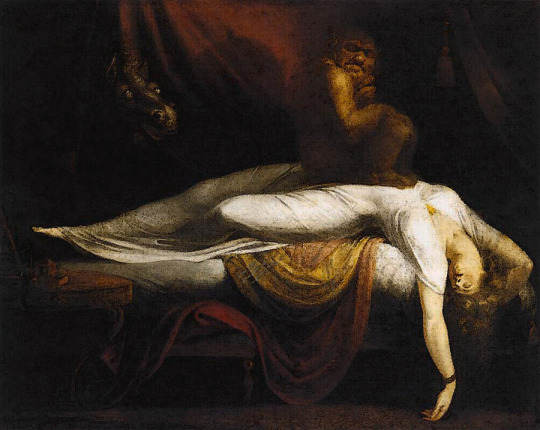
"The Nightmare" by John Henry Fuseli (1781)
My formative years during the late sixties and early seventies took place at a strange juncture in our American cultural history. At the same time that we were loudly proclaiming the supremacy of scientific thought because we'd landed men on the moon, we were also in the midst of a counter cultural explosion of interest in astrology, witchcraft, ghosts, extra sensory perception, and flying saucers. Occult-related books were flying off the shelves as sales surged by more than 100% between 1966 and 1969. Cultural historians would come to refer to this is as the "occult boom," and its aftershocks would impact popular cultural for decades to come.
My first contact with tales of the supernatural were innocuous, largely sanitized for consumption by children. I vividly remember watching Casper the Friendly Ghost and the Disney version of the Legend of Sleepy Hollow. I read to shreds numerous copies of both Where the Wild Things Are and Gus the Ghost. Likely the most important exposure for me was to the original Scooby Doo, Where Are You? cartoon which attempted to inoculate us from our fears of ghosts and aliens by convincing us that ultimately the monster was always just a bad man in a mask. (It's fascinating to me that modern incarnations of Scooby Doo seem to have completely lost this point and instead make all the monsters real.)
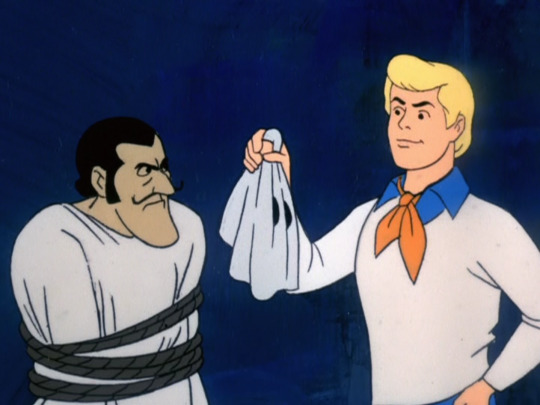
ABOVE: Although the original cartoon Scooby Doo, Where Are You? ran only for one season from 1969 to 1970, it remained in heavy reruns and syndication for decades. It is notable for having been a program that perfectly embodied the conflict between reason and superstition in popular culture, and was originally intended to provide children with critical thinking skills so they would reject the idea of monsters, ghosts, and the like. Ironically, modern takes on Scooby Doo have almost entirely subverted this idea and usually present the culprits of their mysteries as real monsters.
During that same time, television also introduced me to my first onscreen crush in the form of the beautiful and charming Samantha Stevens, a witch who struggles to not to use her powers while married to a frequently intolerant mortal advertising executive in Bewitched. The Munsters and The Addams Family gave me my first taste for "goth" living even before it would become all the rage in the dance clubs of the 1980s. Late night movies on TV would bring all the important horror classics of the past in my living room as Dracula, Frankenstein, the Wolf Man, the Invisible Man, the Phantom of the Opera, The Creature from the Black Lagoon, and Godzilla all became childhood friends. Over time the darkened castles, creaking doors, foggy graveyards, howling wolves, and ever present witches and vampires became so engrained in my psyche that today they remain the "comfort viewing" to which I retreat when I'm sick or in need of other distractions from modern life.
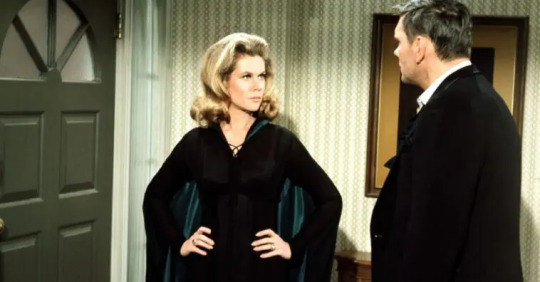
ABOVE: Elizabeth Montgomery starred in Bewitched (1964 - 1972) as Samantha Stephens, a witch who married "mortal" advertising executive Darren Stephens (played for the first five seasons by actor Dick York). Inspired by movies like I Married a Witch (1942) and Bell, Book and Candle (1958), it was a long running series that explored the complex relationship dynamics between those who possess magic and those who don't. Social commentators have referred to it as an allegory both for mixed marriages and also about the challenges faced by minorities, homosexuals, cultural deviants, or generally creative folks in a non heterogeneous community. It was also one of the first American television programs to portray witches not as worshippers of Satan, but simply as a group of people ostracized for their culture and their supernatural skills.
Even before I began elementary school, there was one piece of must-see gothic horror programming that I went out of my way to catch every day. Dark Shadows aired at 3:30 p.m. on our local ABC affiliate in Tulsa, Oklahoma which usually allowed me to catch most of it if I ran home from school (or even more if my mom or brother picked me up.) In theory it was a soap opera, but the show featured a regular parade of supernatural characters and themes. The lead was a 175 year old vampire named Barnabas Collins (played by Johnathan Frid), and the show revolved around his timeless pursuit of his lost love, Josette. It was also a program that regularly dealt with reincarnation, precognition, werewolves, time travel, witchcraft, and other occult themes. Though it regularly provoked criticism from religious groups about its content, it ran from June of 1966 until it's final cancellation in April of 1971. (I would discover it in the early 1970s as it ran in syndication.) Dark Shadows would spin off two feature-length movies based on the original, a series of tie-in novels, an excellent reboot series in 1991 (starring Ben Cross as Barnabas), and a positively embarrassingly awful movie directed by Tim Burton in 1991.
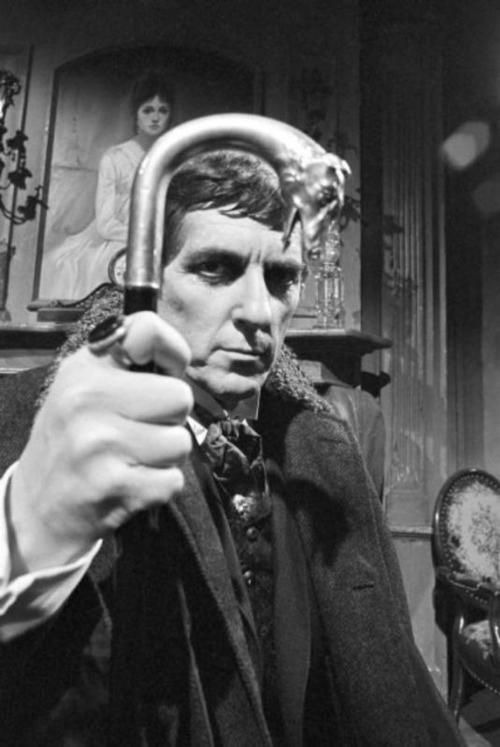
ABOVE: Johnathan Frid starred as Barnabas Collins, one of the leading characters of the original Dark Shadows television series. The influence of the series cannot be understated. In many ways Dark Shadows paved the way for the inclusion of supernatural elements in other soap operas of the 1970s and the 1980s, and was largely responsible for the explosion of romance novels featuring supernatural themes over the same time period.
While Dark Shadows was a favorite early television program for me, another show would prove not only to be a borderline obsession, but also a major influence on my career as a storyteller. Night Gallery (1969-1973) was a weekly anthology television show from Rod Serling, better known as the creator and host of the original Twilight Zone. Like Twilight Zone before it, Night Gallery was a deep and complex commentary on the human condition, but unlike its predecessor the outcomes for the characters almost always skewed towards the horrific and the truly outré. In "The Painted Mirror," an antiques dealer uses a magic painting to trap an enemy in the prehistoric past. Jack Cassidy plots to use astral projection to kill his romantic rival in "The Last Laurel" but accidentally ends up killing himself. In "Eyes" a young Stephen Spielberg directs Joan Crawford in a story about an entitled rich woman who plots to take the sight of a poor man. Week after week it delivered some of the best-written horror television of the early 1970s.
In retrospect I find it surprising that I was allowed to watch Night Gallery at all. I was very young while it was airing, and some of the content was dark and often quite shocking for its time. Nevertheless, I was so attached to the show that I'd throw a literal temper tantrum if I missed a single, solitary episode. If our family needed to go somewhere on an evening that Night Gallery was scheduled, either my parents would either have to wait until after it had aired before we left, or they'd make arrangements in advance with whomever we were visiting to make sure it was okay that I could watch Night Gallery there. I was, in a word, a fanatic.
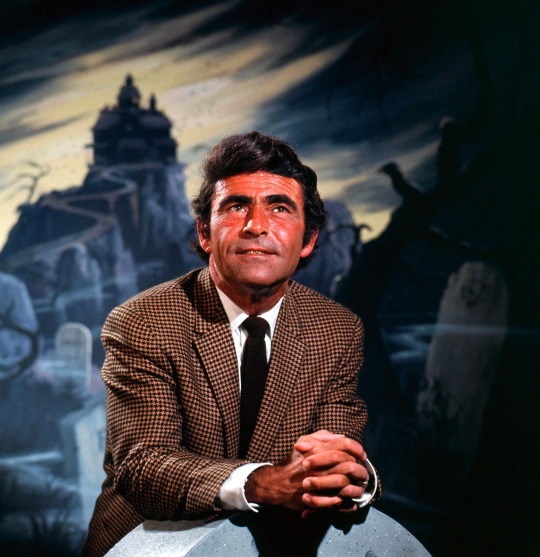
ABOVE: Every segment of Night Gallery was introduced by series creator Rod Serling standing before a painting created explicitly for the series. Director Guillermo del Toro credits Serling's series as being the most important and influential show on his own work, even more so than the more famous Twilight Zone.
7 notes
·
View notes
Text
The Supernatural 70s: Part II - The Month of Darkness
Yet this train's whistle! The wails of a lifetime were gathered in it from other nights in other slumbering years; the howl of moon-dreamed dogs, the seep of river-cold winds through January porch screens which stopped the blood, a thousand fire sirens weeping, or worse! the outgone shreds of breath, the protests of a billion people dead or dying, not wanting to be dead, their groans, their sighs, burst over the earth! ― Ray Bradbury, Something Wicked This Way Comes
When I was a child, the carnivals came in October. They arrived on billowing floats and with shrieks of calliopes, paraded through crowds of cotton candy-huffing children and balloon dispensing clowns, winding through the streets of the city until they at last arrived in the Tulsa Fairgrounds with all the raucous pomp and circumstance of a victory parade. And it was a victory, at least for me, the defeat of the summers that I found oppressive, of the heat that shut my lungs, of the days that were far too bright and too long for my dark-loving soul. They were the celebration of fall and of Halloween and of my birthday month all at once, and to me they were the heralds for the best days of the year.
In many parts of the country carnivals and circuses had largely lost most of their draw by the early 1970s, but in the Tulsa of my early childhood they still constituted major events. They brought with them all of the traditional carnival trappings: halls of mirrors, funhouses with shifting floors or optical illusion-inducing architectures, "freakshows" featuring belly dancers, bearded women, two-headed calves, dubious cryptid curiosities strung together with baling wire and displayed under low-lighting. All of these came and went every year, but one ever-popular horror-inducing attraction during the fair was actually a permanent resident at the fairground-adjacent amusement park, Bell's.
Bell's Amusement Park opened in 1951 on the Tulsa State Fairgrounds. Founded by Robert Kiwanis Bell, it originally featured seven rides, and in 1968 would became home to one of it's star attractions, the wooden roller coaster called the Zingo. In 1971, Bob Bell and his park-founding father Robert decided that the further addition of a dark ride would help grow attendance at the park so they turned to existing east coast attractions for inspiration.
Phantasmagoria, named by Bob, fused gore and ghostly apparitions in one of the longest dark rides of its time, delivering nearly seven minutes of horror for its riders. Its many shocks and scares are among some of my happiest memories of the Tulsa State Fair.

ABOVE: Phantasmagoria opened in July of 1973 and remained in operation until its eventual demolition on June 19, 2007. Although the design of the dark ride was a collaboration between the Bell family and famous ride designer Bill Tracy, the carriages were entirely designed and built by the Bells, and replicas were later exported to dark rides at Joyland in Wichita, Kansas and Wonderland in Amarillo, Texas.
While Phantasmagoria would be the first dark ride I'd ever set foot on, it was not the only one of which I was aware. I'd first caught a glimpse of the granddaddy of all dark rides during a re-run of one of my favorite Sunday night television shows, Walt Disney's Wonderful World of Color. In 1970, Kurt Russell and the Osmonds took a special tour of the recently-opened Disneyland attraction, The Haunted Mansion.
youtube
For the rest of my childhood, The Haunted Mansion would become my most begged-for travel destination, but the cost was too prohibitive for my parents to make the long-distance visit from Oklahoma. Exiled in the Sooner State, I had to content myself with visitations via news articles or photographs. When Viewmaster released their reels with 3 dimensional views inside, I spent many joyous hours drooling over the stereographic images of the 999 happy haunts inside their creepy Victorian home. I was particularly entranced by the images of Madam Leota floating in her crystal ball, of the ghosts dancing in their ballroom, and of the top-hatted ghost performing at his pipe organ. These were images that would haunt my dreams for nearly a decade until I'd finally make my first visit to Disneyworld as part of a high school band trip to Orlando in 1981.
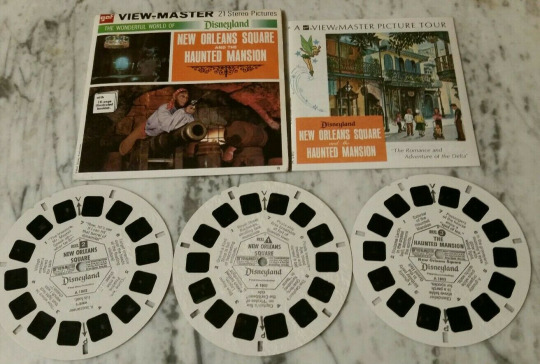
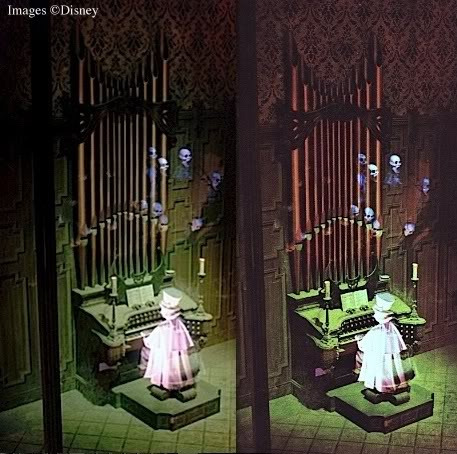
ABOVE: One of the many stereoscopic images of the Haunted Mansion that were available on the Viewmaster. As awesome as it was, my first in-person visit to the Mansion felt like a dream coming to life.
Another classic piece of Halloween-themed Disneyana was a party album originally released in 1964 featuring narration from actress Laura Olsher (the narrator is often misidentified as actress Greyson Hall, best known for playing Dr. Julia Hoffman in the gothic soap opera Dark Shadows). Re-released in the 1970s, the Chilling, Thrilling Sounds of the The Haunted House threaded together ten stories narrated by Olsher on the first side, while the second side isolated the sound effects into individual tracks of screams, thunder, lightning, fighting cats, dogs, creaking doors, explosions, crashes, birds, drips, and flying saucers.
During the 70s, the Chilling, Thrilling Sounds of the Haunted House practically became a requirement if you were planning a holiday party or celebration. You could find it for sale at major national department stores like Sears, at local Oklahoma retailers like T.G.&Y., and sometimes even at convenience stores in the candy aisle. When I went out trick or treating, half the houses I visited had the record playing in the background, and my own family wore out at least three copies of it during the years we were handing out Halloween candy at my parents home. To this day, it still serves as the official soundtrack of my childhood memories of Halloween.

ABOVE: The original version of the Chilling, Thrilling Sounds of the Haunted House released in 1964 featured a white sleeve, but for the 1973 re-release the sleeve was recolored orange. The same piece of art by Paul Wenzel appeared on both versions, and was the original concept art for Disneyland's Haunted Mansion.
If, like myself, you grew up between the 1950s and the 1980s, chances are you had two options for obtaining a Halloween costume. You could either fabricate one yourself out of your parents' discarded clothing, old sheets, your mother's makeup kit, and possibly a discarded box, OR you could trot down to your local five and dime and pick up the always reliable costume in a box. For around five bucks you could live out your fantasy of being Dracula or Frankenstein or Snow White or Batman or maybe a cat, and you might even get the chance to wear it two or three times before you either outgrew it or it simply fell apart. (Although the boxes for these costume kits always prominently displayed that they were flame-retarded, it was not at all too uncommon to hear a horrifying story about a kid accidently setting these costumes on fire because of an unwatched jack o' lantern candle).
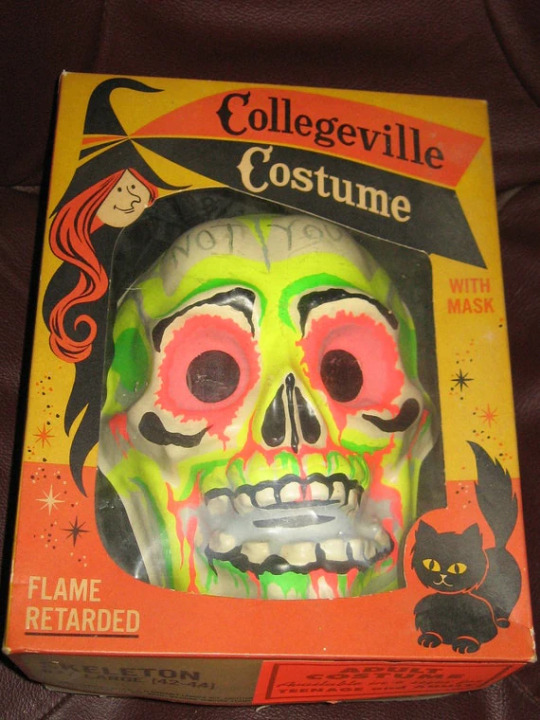
ABOVE: During my childhood I owned a costume in a box kit identical to this one and have strong memories of rampaging through my neighborhood in it while in search of sweets.
As the seventies wore on, I grew more exacting in my standards when it came to Halloween masks and apparel. The "costume in a box" simply wasn't cutting it for me any more. Higher quality and more realistic-looking full head latex masks were appearing on the market by the mid decade, and after a great deal of nagging I convinced my mother to purchase my first legit mask, a terrifically-rendered Creature From the Black Lagoon mask at the Top Hat Magic Shop (at the time the best place in Tulsa to buy or rent costumes). Later on, I'd add a magnificent Mummy mask to my collection. Likely I would have continued to fill the walls of my room with all the heads of my favorite Universal Monsters, but money, wall space, and the limits of my mother's patience kept that fantasy from ever materializing.
By 1975 I had grown into a serious fan not only of the stars of the Universal horror movies, but also of the special effects and make up teams who had made those movies possible. Then, when the October Scholastic Books catalogue arrived that fall, I found a book that would forever ignite my interest in special effects make up techniques. Movie Monsters: Monster Make-Up & Monster Shows To Put On by Alan Ormsby provided a step-by-step breakdown of the makeup that had been used on several classic horror movies. More than that, it also provided detailed, richly illustrated instructions on how to create monster effects using things that would be available in ordinary people's homes. In short order I was fashioning werewolf faces, and Frankenstein heads, and mummy hands all on my own (while also wrecking my parents' home in the process...sorry mom)!

ABOVE: Movie Monsters: Monster Make-Up & Monster Shows To Put On by Alan Ormsby was published by Scholastic Books in 1975. Many of the make-up techniques it demonstrated would spark my interest in filmmaking, and would influence my thoughts on the making of our classic noir horror short, The Case of Evil.
I don't think most people remember when or why they stopped Trick or Treating, but can pinpoint it to the year of my thirteenth birthday. As usual, my best friend, neighbor, and years-long Halloween co-conspirator David Guthridge and I grabbed our candy bags, put on our costumes, and set out to roam the night as we had on so many Halloweens past. We swept along our street, hit all our usual spots, laughing as compared our loot just as we had for all the years of our lives. At last we came to a house on the street behind our own, one we had visited many times, and we rang the doorbell, and we waited.
The porch light flickered. An old woman came to the door. Reflexively we held out our bags and uttered the magic incantation.
"Trick or Treat!"
But the old woman didn't open the outer screen door. She didn't smile or laugh. Her eyes went wide and her mouth gaped, and her expression filled with a look of abject terror.
"WHAT ARE YOU DOING HERE?!" she screamed.
"We're just treat or treating, maam. See..."
"No you aren't! You're too old to be trick or treaters! Get out of here!"
"We're sorry..."
"GET OUT OF HERE! I'M CALLING THE POLICE!"
And her door slammed in our faces. We turned and ran. We ran as fast as our legs could carry us so that we could get back home, ran so the the police couldn't find us and charge us for being too old for trick or treating, too old for candy...
Too old for Halloween.
In the years since, that memory has always stung. It's the defining moment at which I can say that my childhood officially ended...at least by the definition of others. To me, I'm still out there in the dark, on that porch, wondering how I was mistaken for a monstrous adult. It still hurts.
Years later I'd hear a song by Neil Young, a song he'd written when he became too old to enter a club with his younger-than-himself girlfriend. It reminds me eerily of what it was like that night on the last Halloween of my childhood:
Oh, to live on Sugar Mountain With the barkers and the colored balloons You can't be twenty on Sugar Mountain Though you're thinking that you're leaving there too soon, You're leaving there too soon.
5 notes
·
View notes
Text
The Supernatural 70s: Part Three - The Forbidden Tomes
"I saw that the books were hoary and mouldy, and that they included old Morryster’s wild Marvells of Science, the terrible Saducismus Triumphatus of Joseph Glanvill, published in 1681, the shocking Daemonolatreia of Remigius, printed in 1595 at Lyons, and worst of all, the unmentionable Necronomicon of the mad Arab Abdul Alhazred, in Olaus Wormius’ forbidden Latin translation; a book which I had never seen, but of which I had heard monstrous things whispered."
-- H.P. Lovecraft, "The Festival"
It's difficult to be a ghoul when you were intended by your parents to be an apostle. I was raised in a time and place where it was not only assumed that I'd be a good little devotee of the church, but it was expected that I'd grow up to be a fervent, Bible-pounding proselytizer of the AMAZING GOOD NEWS!!!! Before I'd ever been a sinful gleam in my father's eye, my mother frequently attended the crusades of Billy Graham. I'd had the fortune (?) to grow up in Tulsa, Oklahoma which was home to Oral Roberts University, officially making my hometown the crossbar of the buckle of the Bible Belt.
As a kid my childhood routine was strongly ordered. Sunday school and church twice on Sundays. Wednesday night church as well. Bible study and prayers every night before bed. Both of my parents taught Sunday school for the youngest kids in our church, and I was defacto enforcer to keep some of the more "troublesome" kids in line as my parents laid down THE LAW. Frequently too there were cartoons produced by Disney featuring that rat-bastard Jiminey Cricket who was supposed to be our kindly voice of conscious but I'd grow to hate him as the All Seeing, All Controlling monitor of everything I ever did. Come summer time I was riding the bus with the pastor to church every day for Vacation Bible School to ensure that not one single sinful thought ever entered my pre-pubescent mind. But there's something to be said about trying to tamp down the lid on all that, to make sure every thought is clean, and pure, and in the absolute service of the All Mighty. The more that I was preached to about hell and brimstone and the eternal punishment that was waiting to pounce on my sin-tainted soul, the more interested I became in reading and watching the things that were supposedly lurking out there in the shadows to imperil me. Honestly, it was almost as if they'd wanted me to become a horror fiend. The most paradoxical thing about my intense religious upbringing is that my parents - most particularly my mother - were strangely inconsistent in the ways in which both my older brother and myself were raised. Neither of my parents ever read for pleasure for themselves, but there wasn't a single night of my childhood when I wasn't read to sleep until I was old enough to read for myself. By the time I hit elementary school I was already a voracious reader and reading at a grade level far in advance of where other kids my age were. Awards were given out every semester for the student who read the most books and I routinely read more books than the pre-printed certificates even accounted for. Somehow, no one had ever thought a kid my age might blow through more than 25 books in a semester!
Feeding a literary appetite like that wasn't easy. Being a good boy I'd read all the wholesome things I was supposed to read beyond my assigned Bible readings. Dick and Jane. The Poky Little Puppy. Clifford the Big Red Dog. Winnie the Pooh. Pippi Longstocking. Frog and Toad are Friends. Bedtime for Frances. Go Dog Go. Curious George. The Richard Scarry Treasury (which while I loved them, I was disappointed that despite the author's name they weren't at all scary.) Sometimes I'd also sneak in a few comic books that were supposed to be good for me because they were bible stories or Classics Illustrated.

ABOVE: Classics Illustrated exposed many children to their first classical works of literature, and I was absolutely hooked on the volumes which covered Shakespeare, particular Macbeth and Hamlet, both of which played heavily with supernatural elements like ghosts, witches, curses, and prophesies.
Of course, as I mentioned in part one of this series, I'd snuck in a few juvenile-oriented books with ghost or monster themes to them, but those titles always skidded past my mother's radar because the supernatural elements within them were little more than window dressing. Casper and Gus were happy, friendly ghosts who were going out of their way trying not to frighten the people they encountered. The terrible creatures of Where the Wild Things Are are easily dismissible as figments of Max's sleepy imagination. But as the material I was watching and reading became both more sophisticated and less morality play-like, the less comfortable my parents became.
An important breaking point for my mother's tolerance would come on October 27 of 1973 with an episode of the Star Trek animated series entitled "The Magicks of Megas-Tu." Written by Larry Brody, the story followed the crew of the Starship Enterprise as they are caught in a mysterious storm and thrown into an alternate universe where science doesn't work but magic does.
Aided by a horned man named Lucien who appears on the bridge and repairs the damaged Enterprise, they are advised not to attempt to use magic themselves to avoid attracting attention, but the advice falls on deaf ears and the crew find themselves abducted and transported to a place which resembles the witch-trial era of Salem, Massachusetts. Placed on trial by for acts of witchcraft alongside Lucien, Kirk and crew must square off against the prosecutor, Asmodeus. Spock indicates that there's a good possibility that Lucien is actually either the Lucifer of Earth's history, or at least his inspiration, but Kirk points out the witches of Salem had been wrongfully accused, Lucien hasn't done anything wrong against them and so he defends Lucien against the prosecutor saying that he'd be willing to give his own life in exchange for Lucien to prevent him from being cast out.
The storyline would be a bridge too far for my mother. The idea that Lucifer might have been an alien rather than the devil, or that the hero of my favorite sci-fi TV series was prepared to save him even if wrongfully accused was too much. Even though presented entirely as a fictional scenario, it would set my mother permanently against all sci-fi, fantasy, or horror fiction that drifted into our household. It would cement of pattern of active censorship over genre fiction in that had originated because of my older brother Gene.
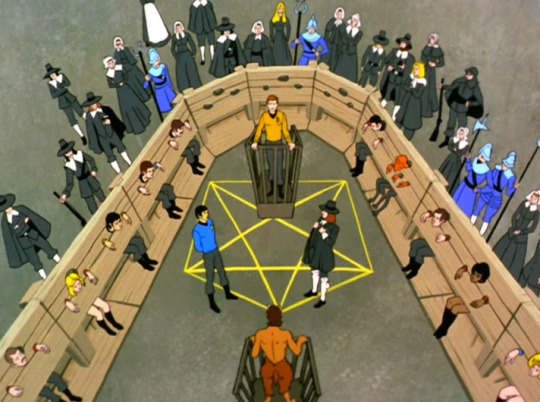
ABOVE: Kirk defends himself, the rest of the crew, and the magic-wielding alien named Lucien against the Megans in a trial resembling the Salem witch trials. The episode was written by screenwriter Larry Brody who coincidentally also created a series called The Magician that debuted on CBS the same year and starred Bill Bixby.
Much of my taste for science fiction, fantasy, and the paranormal began thanks to the influence of my older brother. He had been the one who pioneered the way for me, watching Lost in Space, Star Trek, Twilight Zone, The Time Tunnel and Voyage to the Bottom of the Sea during their original runs, then telling me about them long before I experienced most of them on my own. It was also thanks to him shoving The Hobbit at me in junior high that I ever discovered Tolkien, and also because of him that I first started scribbling down short stories. In so many respects there would never have been a Neal Hallford horror aficionado or game designer if not for his influence over me.
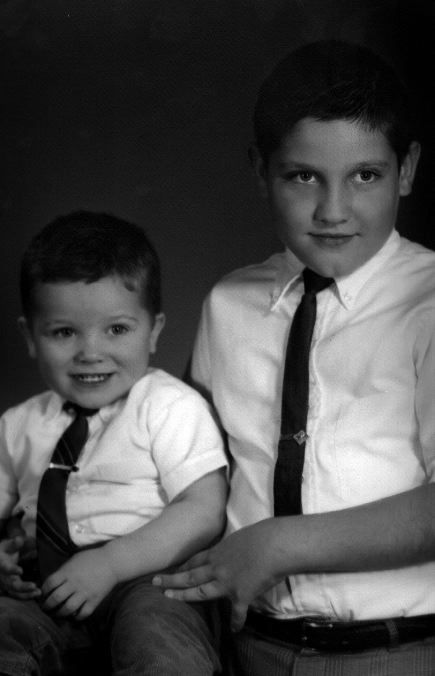
ABOVE: My brother and I
My long trek to the dark side started when Gene tried to check out books about bigfoot and UFOs and ESP from the Tulsa County bookmobile. Today this wouldn't even raise an eyebrow in most places, but in early 1970s Oklahoma this constituted scandal. Children weren't supposed to read about that sort of thing. Dire conversations were had with my parents. Pastors were consulted. For this unspeakable crime against humanity, he found himself banned from the bookmobile. But the thing about banning things from kids is, they're just going to find another way to get to what you don't want them to have.
In the 70s, there were all kinds of interesting books and comics popping up on magazine stands and in convenience store "spinners." If you wanted books about space travel, reincarnation, psychic phenomena, vampirism, cannibalism, or the occult, the books were certainly available. Gene was tantalized by all these verboten bits of reading material, but getting the allowance money to buy these things came from our mother, and she wasn't about to pay for any of this potentially blasphemous trash. Interestingly enough, Gene found an ally in a lady that my family members simply called "Aunt Patsy."
My Aunt Patsy wasn't actually an aunt, but an elderly 2nd or a 3rd cousin. She and I had a birthday in common, so I have many childhood photos of our shared celebrations. Unfortunately, Patsy was something of an outcast within our family and not terribly well-treated. I seem to remember whispered stories that she'd been a fan dancer or something of the sort when she was younger, but I was very little and I didn't really understand what all the fuss was about. My father went out of his way to look after her, however, and so she was practically a part of my daily life when I was small. Whatever the case may be, whether she was a closet radical, or she simply couldn't say no to my brother, she would secretly slide him the money when my mother refused to pop for one of Gene's "suhtonic" books.
Gene amassed a remarkable stash of books which, of course, became the core of my secret lending library as I aged up enough to read them. Ghost stories were my favorite, followed by weird tales of ESP or British stories that fell into the genre that is now known as "folk horror." But there was one series of books in particular that latched into my brain, and even though in time I'd forget the titles and author names, the covers became indelibly burned into my brain. They all featured exactly the same design. Four illustrated panels on the front covers, and usually two panels on the back. The illustrations were all monochromatic, fantastically lurid line drawings that would have been right at home in the horror comics of the day. Each illustration would have wonderfully evocative captions like "Uncanny Granny's bedtime tales that come true," "The incredible dog who predicted his master's death," "He returned from the dead to rescue his son," "His bizarre powers tracked down a hidden killer," and "Rosemary's candle is a warning from another world." Published by Popular Library, they would become the books that would create my love for stories featuring the supernatural.

ABOVE: My recently reconstructed "Aunt Patsy" collection of Popular Library books about the paranormal. Although I'd forgotten the authors, titles, and publisher, I still remembered the images on the covers and after numerous Google keyword and image searches, I finally was able track these down from multiple sellers. They are ESP Forewarnings by Robert Tralins, Clairvoyant Women by Robert Tralins, Powers That Be by Beverley Nichols, Beyond Unseen Boundaries by Brad Steiger, Weird People of the Unknown by Robert Tralins, and Clairvoyant Strangers by Robert Tralins. (Not pictured is Supernatural Strangers by Robert Tralins which is still on the way from an Abebooks dealer).
Another set of books that I loved was a fantastic illustrated encyclopedia called Man, Myth, and Magic released in 1970 by the Marshall Cavendish Corporation. Compiled from articles in a magazine of the same name, it was a wonderfully comprehensive 26 volume set with loads of photographs, drawings, and diagrams of all things supernatural. It also had articles covering topics which were not in and of themselves supernatural, but were weird or controversial enough to be of potential interest.
At some point during one of her regular Orwellian sweeps of our rooms to look for illicit reading materials, my mother happened upon said encyclopedia and while flipping through it stumbled on a helpful entry about the history of ritual parricide, i.e. the murder of one's parents. Seeing this, she decided that this one entry out of thousands was advocating the practice, and was quite possibly the reason my brother had purchased all twenty six volumes. The books were then summarily gathered, removed, burned, and my brother informed and punished ex post facto.
Now, for most families, the book burning would have been the end of the tale, but I didn't grow up in most families. Before I relate the paradoxical aftermath of this, let me first refer you back to what I mentioned near the start of this post. My parents or my brother read to me to sleep nearly every night as a child. I was raised with a near reverential regard for both books and for reading. Burning a book, regardless of its content, was a cause for deep seated guilt. It simply isn't done. But my mother had committed this unconscionable act - even in the name of correcting her Satan-deceived son - and she had in some way to make up for this. So what did my mother do? She reached into her purse, pulled out money, and gave him money with the idea that he would, now properly chastened, go out and buy something which would be wholesome and uplifting and lead him back to the Lord. Surprisingly to her, another copy of the encyclopedia would appear in his room shortly thereafter.
This would become a pattern for the remainder of our childhoods.

ABOVE: The first three volumes of Man, Myth & Magic are in my POSSESSION (see what I did there) as I reconstruct the set for my own collection. It is really an excellent reference as well a great time-capsule for views on the supernatural during the sixties and seventies.
By the time I reached junior high, my love for supernatural horror stories had settled on the greatest classical exponent of the genre, Edgar Allen Poe. Whenever horror movies based on his works turned up on TV, however loosely they might be based, I would greedily gobble them up. As I began to write short stories of my own, most were pastiches about premature burials, lost loves, and other themes commonly found in his stories.
It was thanks to this passion for all things Poe that my eyeball would find the cover of a book that I found highly compelling while shopping at a newly minted B. Dalton's bookseller. The title and the subject matter seemed like something straight out of good old Eddy's oeuvre, but it would turn out instead to be my first step into the sanity-blasting cosmic horrors of H.P. Lovecraft.
I cannot overstate how important and how big a role that the discovery of Lovecraft would be to me. His works would present, for the first time to me, a view of horror that was not just an encounter with an isolated vampire or a monster, but one that represented a cosmic conspiracy against all of mankind. It was the first time I'd encounter the concept of a "shared universe" that was co-created by several different authors and to which were being added new stories on an almost daily basis. Lastly, and most importantly, it would ultimately lead me to the discovery the Call of Cthulhu role-playing game based on his works which in turn would teach me the interactive narrative skills that would one day land me my first job as a game designer.

ABOVE: The edition of H.P. Lovecraft's The Tomb that I discovered in junior high. The cover was gloriously and horrifically illustrated by Michael Whelan and was part of a larger painting that was divided between the covers of other collections of Lovecraft's stories.
As a bit of a post-script on the topic of supernatural novels of the 1970s, I have to mention Jay Anson's book The Amityville Horror (which has since been adapted in several movies as well as subsequent books.) Although I can't say the book was particularly influential on me, I will confess that more than any other book of it's day, this is the book that scared the absolute hell out of me.
Purportedly based on a true story, Amityville got under my skin because the details felt so relatable. It wasn't a gothic novel set in a castle, the events didn't happen a hundred years ago, and even the most overtly supernatural elements were painted in a utterly believable way. But the detail that got me, the one that kept me awake at night related to Jodie, the imaginary friend of the daughter, Missy Lutz. Described as a demonic pig, the book describes a scene in which Jodie's glowing red eyes are seen looking in the window of Missy's bedroom which was not on the ground floor.
Years before ever reading the book, my brother and I had always shared a nightmare about otherworldly eyes looking into his bedroom window, a window that 12 feet above the ground of our back yard. A window that still gives me shivers to look out of at nighttime when visiting my mother's house.
Goodnight kids!
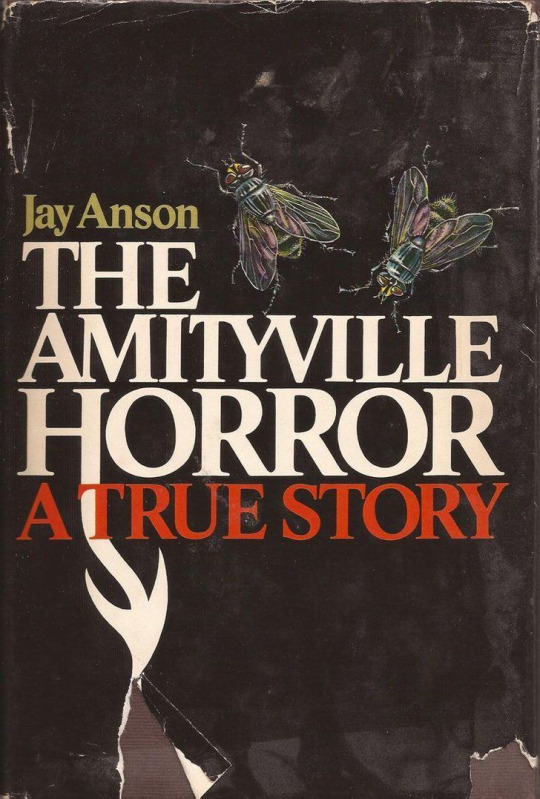
11 notes
·
View notes
Text
The Supernatural 70s: Part Four - Flickering Phantoms
There was a thing in our basement.
It crouched in shadows, waited until the skies turned black and the winds howled and the windows shook, waited until we had no choice but to descend the steps and keep the wretched thing company. Once we gathered, it would open a single, unblinking eye on us, and it would begin a recitation of town names, and trailer parks, and intersections, places which once had been but now no longer were, places forevermore erased from the face of earth. And so for hours there my family would sit, entranced by our cyclopean demon, fervently hoping that its next apocalyptical pronouncement would not include anything about us.
If you haven't lived in America's so-called "tornado alley," you might not fully appreciate that a television set occupies a special place in the lives of alley-folk. Beyond being a source of entertainment to us, or a window on current world events, a television served as a safety device. It told us where the tornadic storms were, where they were going, and whether or not we should get Fluffy out of the yard. It also served as an anxiety dispenser as we watched the tornadoes pass by - or more frequently through - the places where our friends and loved ones lived. Given this, you can understand why so many of us wanted televisions in our basements. We needed something to watch while we were huddling down there in the dark and hoping not to die. Furthermore, with TV, we had a pretty good idea when it was safe to come out of our hidey-holes.
Of course, one of the big problems with using a TV for this purpose was power. During a tornado, it was always possible that the electricity would get knocked out by high winds or lightning strikes. Battery-powered radios were certainly an option, but nothing beat being able to see on radar exactly where the action was going down. Thankfully, for those of us who had to deal with this quandary, Sears popped up in the mid 1970s with a portable, (seemingly ten-thousand pound), 13 inch, battery-powered television set that would allow us to stay on top of the news even when the power went out. Being the safety-conscious woman that she was, my mother dutifully bought one of these believing that we could keep it in the basement for emergencies. I, however, had other plans.
Like most children my age, I didn't have a television in my room. Beyond the fact that such things would have been considered irresponsibly extravagant back in the day, the prevailing wisdom of the time was that TV was bad for children. It disrupted our sleep patterns. It gave us nightmares. It led to bed-wetting, anti-social tendencies, communist sympathies, and probably Satan worship. When added to the fact that I, like my mother, was a nocturnal creature with insomniac tendencies, the last thing my parents wanted to do was put a TV in my room. But the devil of the thing was, it proved almost immediately to be an effective mobile babysitter for me. When we made long distance trips out of town, my parents didn't have to make special arrangements anymore so that I could watch Night Gallery or Star Trek. When my mother taught night school for adults or later at the Salvation Army unwed mother's home, it was easy enough to park me in a nearby room with a pair of headphones to keep me distracted. So when I began to start keeping the portable TV in my bedroom at night so I could watch late night horror movies, my battle had already been won.
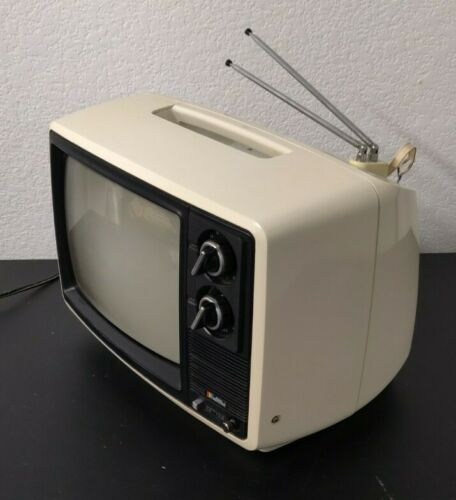
ABOVE - A Sears 13" portable television similar to the one my family bought in the late 1970s (ours was brown, and only displayed black and white). Not only did this become my gateway to fantastic television, but it would also become the monitor I used to connect my Atari 400, my first writing tool along with being my first computer gaming platform.
In addition to all of the Universal horror flicks from the 1920s-1950s that I already loved, my illicit little TV introduced me to the heavily Bowdlerized 1960s versions of Dracula, Frankenstein, and the Mummy presented by the greatest house of horror ever, Hammer Films. I would also discover the magnificent cycle of Poe films made for American International which enshrined a new triumvirate of terror formed by Christopher Lee, Peter Cushing, and Vincent Price. But above all else, it was a movie made in 1970 that I would discover during an "afternoon movie" on Tulsa's KOKI that would become one of my favorite horror movies.
I can't honestly count the number of times that I've watched The Abominable Doctor Phibes. Before the advent of home video, I made sure I caught every airing of it on TV, and if it ran in the film room at a local convention, I'd drop everything to make sure I was there to watch, regardless of the hour. I'm fairly certain I squealed out loud with joy the first time I found it on video cassette, and I've owned a version of it (and its sequel) in practically every medium in which it has appeared since.
Starring Vincent Price at his most malevolent but velvety-voiced best, Doctor Phibes follows the story of a hideously disfigured genius hell-bent on avenging himself on the doctors who failed to save his dead wife. Aided by his gorgeous assistant Vulnavia, he uses the ten biblical plagues as inspiration as he offs his victims one-by-one with a stylish sense of aplomb, all between performing private pipe organ recitals inside an art deco tomb. If you've never seen it, you've missed one of the most gloriously bonkers, over-the-top horror feasts of all time.

ABOVE: The Abominable Dr. Phibes is a deliciously fun cult favorite, and altogether one of the most stylish horror movies ever created.
Our portable TV became a frequent co-traveler with me as we took long trips to visit various relatives scattered across the state of Oklahoma. Most frequently I had it with me when we headed down to my grandparents' farm south of Haskell. Their home was an old, creaky homestead situated on a hundred acre plot of land in the middle of nowhere, accessible at the time only by long, desolate stretches of gravel road. Without the TV it was easy to feel isolated on the trips back home. The world outside our station wagon was often pitch black, with nothing visible but dark clumps of trees that crowded too closely to the road. Sometimes things would appear in our headlights, appearing and disappearing before we could ever clearly identify what they were. I didn't like to think about what might be lurking unseen just outside of our view, what might be watching us from the shadows. These fears would be greatly amplified and played upon by the next movie in my list.
In November of 1972, The New CBS Tuesday Night Movies presented what was easily one of the most traumatizing horror films of my young life, namely the made-for-TV movie, Gargoyles. Starring Cornel Wilde and Jennifer Salt (later of TV's Soap fame), the story follows the research trip of Dr. Boley and his daughter as they travel through New Mexico to a roadside attraction, Uncle Willie's Desert Museum. Uncle Willie (played by Woody Chambliss) has invited Dr. Boley to see something he's got hidden in his shed that he doesn't show to all his tourists, namely the skeleton of an ancient gargoyle! As Willie unspools the ancient Indian legends about the creatures for his visitor, the shed is suddenly attacked, the building catches fire, and Willie is killed in the chaos.
Fleeing the burning building, Dr. Boley and his daughter leap into their station wagon and head off down the road. Confused and horrified by what's just happened, they decide to play back the recording of Uncle Willie's tale in the hopes of figuring out what the hell is going on. No sooner than the tape gets rolling, however, their station wagon is beset by a flying gargoyle. Landing on the roof, it attempts to claw itself inside while Boley steers wildly to try to shake it off, eventually ditching the creature in the weeds. (It is thanks to this scene that being in a car in the middle of the night on a gravel road still gives me the heebie jeebies!)

ABOVE: Although it was a made-for-TV movie with a relatively low budget, Gargoyles featured some truly outstanding creature effects created by the legendary Stan Winston. The lead gargoyle was brilliantly portrayed by actor and former football star, Bernie Casey.
The terror of the open road that Gargoyles inspired in me as a child was not something that afflicted my father. If anything, he likely would have spent all his time behind the wheel of a car on his way to god-knows-where if he hadn't had a wife and two kids to support. Because both of my parents were teachers and had the summers off, we had the luxury of taking a long road-trip every summer. In most cases we didn't even know where our father was taking us when we got started, but only that we should expect to be on the road for a long time and be prepared for practically any contingency. This meant that we kicked off every trip with a silver, coffin-sized ice chest that extended the entire width of the station wagon that was stuffed full of Oscar Meyer hot dogs, bologna, American cheese, Miracle Whip, mustard, milk, a couple of loaves of Rainbow bread, and a box each of Twinkies and Ding Dongs. On a split second notice we'd be tumbled out of our beds at dawn with our noses pointed toward Destination Anywhere.
This devil-may-care attitude of my father in regard to our travel plans meant that we often ended up in peculiar circumstances. On more than one occasion I can recall driving through storm systems that were spawning tornados in front of or behind us, and spending some nerve-wracked evenings in motels that lacked convenient storm shelters. More than once we slept in rest stops when we discovered that the towns where we'd been anticipating pulling in for the night had no vacancies. Or even motels. In the age before car navigation systems we often ended up lost because of my father's predilection for "short cuts." On one particularly memorable night at about three o'clock in the morning while rolling down a single-lane road in Colorado, we were startled by a sudden Close-Encounters like light that erupted in the middle of the road in front of us. Men with guns appeared at our car windows and we were coolly informed that we'd found the secret entrance to an air force facility, and we needed to turn around and go back to wherever we'd come from in a hurry.
When Race With the Devil starring Peter Fonda was released in 1975, I felt almost as if someone had been spying on our family experiences for inspiration. Combining an accidental encounter with Satan-worshippers while on a road trip in a Winnebago, Race is quite possibly the most 70s horror movie ever conceived. Camping and road trips were all the rage in the early to mid 70s, and Winnebagos were one of the most lusted after commodities of bored suburban dads (I spent more than a little time haunting car lots in Tulsa with my father as he drooled over these automotive beasts.) The 70s were also the golden age of cinematic car chases, so mixing all of these elements together had to have been a no-brainer for the movie's producers. It would become the movie that made you too terrified to take a break at a deserted rest stop ever again.

ABOVE: Peter Fonda co-starred with the always amazing Warren Oats in this non-stop action thriller from 20th Century Fox.
Wiccans were a recurrent target of the horror movies of the 1970s, and their beliefs and practices often were wildly distorted in order to cast them in the role of evil, devil-worshipping, murder-minded villains. These films as a whole perpetuated harmful myths about a largely marginalized community, and I can say from personal experience that the vast majority of the self-proclaimed witches that I've ever met have been kind, nature-loving peaceniks who bear no resemblance whatsoever to the cauldron-stirring variety found on film. That said, if we view the witches of cinema as wholly made up monsters rather than representatives of any real world religious community, there are some exceptionally good witchy horrors that came out of the era.
Crowhaven Farm is quite possibly one of the best of the bunch, rising far above the rest with a well-crafted story that elevated it above its cohort. Diving into the familiar waters of clandestine conspiracies, mysterious pregnancies, and creepy children, it also touched on another paranormal subject about which many other filmmakers became obsessed during the supernatural 70s, namely reincarnation.
Released originally in 1970, Crowhaven Farm popped up periodically in reruns and originally caught my attention during a late night showing because, for whatever reason, I conflated the star Hope Lange with Bewitched star Elizabeth Montgomery (in retrospect I'm not sure how I made this mistake, aside from the fact that they were both pretty blonde housewives in shows about witches.) In Crowhaven, Lange and her husband move into an old house in the country, but shortly thereafter she begins to be haunted with nightmares of being crushed to death during the Salem Witch Trials, dreams which she will soon learn are not dreams at all but memories of her previous life as the condemned witch "Meg" Carey. Filled with several twisty plot turns, this sophisticated suspensefest feels like something bigger than the made-for-TV movie that it was.

ABOVE: The puritans gather to stone "Meg" Carey to death for witchcraft in one of Lange's memories of her past life in Salem. Prior to her role in Crowhaven, Lange starred in a short-lived TV series adaptation of The Ghost and Mrs. Muir.
Another common supernatural fixation of the 1970s had to do with the body of water found between the southern tip of Florida, the island of Bermuda to the east, and the island of Puerto Rico in the south. Commonly known as the Bermuda Triangle, this region has a long history of mysterious nautical legends ranging from missing ships, missing airplanes, strange fogs, electromagnetic disturbances, UFO sightings, and all sorts of other weird phenomena. Stories about it made regular rounds in newspapers, news programs, and in documentaries all through the decade. For me, however, that region of the Atlantic Ocean is fixed forever in my imagination thanks to the chilling ABC horror thriller, Satan's Triangle.
Released in 1975, Satan's Triangle kicks off with a pair of Coast Guard pilots being called in to rescue a stranded boat. Once there, they discover a priest hanging dead by his ankles from the main mast, another man dead in the forward hatch, another seemingly floating in mid-air below decks, and the only survivor a terrified but speechless woman hiding in a darkened cabin. After the initial attempt to rescue her fails because of an accident, one of the rescuers is forced to remain on board with the woman as she begins to recount the eerie events that left her the only personal alive aboard the drifting vessel. Even as rescue finally does arrive for them both, however, a final twist reveals that nothing is what it appears to be.

ABOVE: Kim Novak and Doug McClure star in this taut little supernatural thriller from director Sutton Roley. As with Crowhaven Farm, over the years my mind played strange tricks on me, and until I was able to later re-watch it in the 2000s, I was thoroughly convinced that Roddy McDowell had been in the cast (spoiler: he wasn't.) Combining elements of the Flying Dutchmen with various legends about the Bermuda Triangle, this remains one of my favorite sea-bound horrors.
In the very same year that Doug McClure was making the biggest mistake of his Coast Guard career in Satan's Triangle, one of my all-time favorite horror heroes took his first bow. Kolchak: The Night Stalker starring Darren McGavin followed the adventures of intrepid newspaper reporter Carl Kolchak as he tried to stop, or at least report on, the innumerable supernatural horrors that plagued the cruel streets of Chicago. During his brief tenure on TV he faced down vampires, demons, dream monsters, zombies, Aztec mummies, living suits of armor, and a whole host of other menacing monsters. Inspired by these adventures, television producer Chris Carter would later go on to create the X-Files which bore an incredible debt to The Night Stalker. Carter would even go so far as to introduce a character played by Darren McGavin as the originator of the FBI's X-Files, giving the fans an in-universe meta acknowledgement that Mulder and Scully had Carl Kolchak to thank for their start.
What I loved about Carl, and what I know others connected with as well, is that Carl wasn't a slick, well-respected reporter. He worked for a boss who didn't respect him, and didn't believe any of the bizarre stories that Kolchak brought to the paper. But Carl had street-savvy, and he knew his way around the the rejects of his community. He was frequently broke. More often than not he bungled his way to success, but he always got his story regardless of whether he could convince his editor to print the truth. In so many ways he mirrored other television detectives of his era like Peter Falk's Columbo and James Garner's Rockford, loveable oddballs all that we were rooting for because we could see ourselves in them. This identification was especially important to me because he arrived around the time that I was beginning to think about my future career as a writer, and the evocative idea of a monster-hunting reporter took a firm hold of my imagination.

ABOVE: Although Kolchak: The Night Stalker only ran for one season, it became a cult hit and would go on to influence several other horror programs, most notably Chris Carter's X-Files.
For the bulk of the 1970s, I discovered horror movies thanks to their appearance on late night or afternoon movie programs available through my trusty portable TV. Most of those films would be made-for-TV productions like those I've listed above. For this reason I missed the original theatrical runs of important movies like The Exorcist, The Omen, The Town That Dreaded Sundown, The Texas Chainsaw Massacre, and The Amityville Horror. I would discover these classics only years later when I was able to rent them on VHS away from the disapproval of my parents. My long isolation from horror on the big screen would at last come to a screaming end with the arrival of 1978's The Manitou.
To be honest, I don't really recall much about the movie. I've only ever seen it one time, but I do remember being seriously freaked out about its weird combination of reincarnation, self-aware tumors, and Native American spiritualism. I'm not even sure I really got it all at the time, but it was nothing at all like the relatively genteel horror flicks I'd remembered watching at home on my tiny screen. But however good or bad it might have been, it represented one of my first steps towards adulthood.

ABOVE: The Manitou was a deeply messed up movie based on a book of the same name by horror writer Graham Masterson. I do not recommend viewing it if you are at all bothered by any lumps, bumps, or growths that you have on your body.
3 notes
·
View notes
Text
THE THIEF OF DREAMS: PART I - Resets & Revolutions
Every time I begin a new project, I start with the compilation of encyclopedia for the world that I'm building so that I can organize all of my notes about cultures, religions, politics, and major world events. These encyclopedias tend not to be directly related to the plotline, but instead are about laying down the foundations of the world in which the story will be built. They're a kind of workshop for figuring out the mechanics of how things function and what motivates the characters. Already, the encyclopedia for The Thief of Dreams is approaching novel-length just on its own and is undergoing constant updating and rewriting. It can't be treated holy writ until the first novel is done because I'm still learning new things every day.
Creating the encyclopedia, even for a fantasy world, requires a great deal of real world research...at least for me. It's absolutely possible to write a world that is nothing at all like our own, but honestly, a setting like that becomes very difficult to make communicable and relatable to a reading audience. That's why we see so many fantasy novels that are really just analogues to medieval England, or China, or downtown Chicago, or pick your setting de jour. At the outset, I had intended the setting to be something akin to Enlightenment-era England with an overlay of the politics of the Italian Republics during the Renaissance. But the more that I dug in and researched and wrote, I found myself gravitating increasingly to a different cultural touchstone: mid-19th century and pre-Revolutionary Russia.
In one of my earliest list of characters that I originally had intended to develop for The Thief of Dreams, there was a minor character named Zhari who was dealing with a revolution unfolding in her home country. The more that I worked on developing her story, however, I found that her milieu was more compelling than either of the characters I'd originally intended the novel to be about. And so, after a great deal of soul-searching, I upended the entire premise of the book for her. In doing so, I discovered that I immediately understood a great deal more about the world and the plot.

HEROINE OF ZHOVAR - A slapped together composite reflecting how I imagine the main character, Zhari Eknoya, to appear at the start of the novel.
Perhaps it was because I'd grown up in the 1970s and the 1980s, and I already had a strong affinity for the spy stories of my childhood, all of which involved the Soviet Union. In my imagination, Russia was always an exotic place, a nation evidently populated by chess-loving, novel-writing, deeply passionate people who were struggling to find an identity between their tsarist past and a (potentially) democratic future. I always found Russian characters much more interesting and nuanced, caught between so many conflicting personal and cultural stressors. Once I began to try to step into this mindset, I at last began to see the world of the novel much more clearly, though what I'm creating can't be seen as a 1:1 parallel. There's a lot that's going into the pot from other real-world cultures, and there's some stuff that will owe more inspiration to fantasy novels (and a computer role-playing game in particular) than history books. Hopefully you'll enjoy the recipe.
2 notes
·
View notes
Photo

A bit of self-inspiration for the fantasy novel I'm writing, evoking the mood I'm after. The painting is re-colored version of "A View of Dresden by Moonlight," by Johan Christian Dahl. (If you can't hear the implied cimbalom, I'm not playing it hard enough.) This won’t be an elves and dwarves sort of fantasy novel, but more along the lines of if Dostoevsky wrote a le Carré Enlightenment-era spy novel set in an imaginary country that resembles an early 19th century Russia. And of course there are gods and magic. :)
1 note
·
View note
Photo

Now I am studying Ingmar Bergman, including The Seventh Seal and Wild Strawberries, both from 1957. My professor said we should wear all black, smoke European cigarettes, drink lattes, and try to act like intellectuals while watching these films. #classicfilms #ingmarbergman #theseventhseal #wildstrawberries #1957films #arthousecinema #arthistorygradstudent (at Spring Valley, California) https://www.instagram.com/p/CLSavZODtKc/?igshid=11fddo7bur5b7
3 notes
·
View notes
Text
“The Derrick”: Part I - Returning To My RPG Roots
I’ve chosen to create a short game scenario set in a universe I’ve been building for literally decades. “The Derrick” has been a very long time in coming.

THE DERRICK - The title card for a possible upcoming interactive horror mystery game.
Now as with almost every story I ever tell you, I have to back up a bit to explain where some things have their origins, specifically the concept behind "The Derrick” as well as the fictional setting of Adams, Oklahoma (in which my upcoing short story “The Tome” is also set).
Like a lot of kids who grew up in the 1970s and the 1980s, I was an avid player of Dungeons & Dragons, and I spent a lot of time kicking down doors, slaying monsters, and trying to hit on succubi (since I couldn’t land a girlfriend in real life in those days). It was a marvelous first introduction to the world of role-playing games.
One day while perusing my favorite game store in Tulsa, Oklahoma I accidentally came across something which nearly cost me my sanity -- which was highly appropriate given that the game in question was the RPG Call of Cthulhu based on the works of H.P. Lovecraft. I was already a gigantic fan of Lovecraft’s literary work, and had devoured nearly everything he’d ever written, but the possibilities of actually playing in his horrifying universe was something that immediately “called” to me. I remember being so excited about it that I didn’t even wait to get home to break open the box, and I sat in the parking lot reading the instructions in my non-air-conditioned car on a punishingly hot Oklahoma summer day.

ROLL FOR SANITY LOSS - Discovering Chaosium’s Call of Cthulhu boxed set introduced me to the sanity-losing joy of one of the best RPG systems ever devised. Several year’s later, Call of Cthulhu developer Sandy Petersen wrote the introduction to my book “Swords & Circuitry: A Designer’s Guide to Computer Role-Playing Games.”
By the time I finished reading through the full rule set (thankfully in cooler circumstances), I realized that I’d finally found the game system for me. D&D was hellaciously fun, but sometimes the gameplay felt repetitive. With my group, we mostly spent our time murdering monsters to get their stuff so we could get better equipment to kill bigger monsters to get even better stuff...rinse and repeat ad infinitum. Call of Cthulhu, however, was a game that was about exploring mysteries, solving puzzles, and doing your dead level best NOT to end up in a gun battle with eldritch Outer Gods (which never, ever, ever went well for players who tried to pay CoC like it was just D&D in 20s drag.) I loved that players were constantly battling to stay sane, and that everyone was HIGHLY mortal. Characters never leveled up to being unkillable demi-gods. You were always at risk, always challenged, and you had to use your head while simultaneously terrified about what was lurking around every corner. If you did your job properly as Keeper -- essentially a role equivalent to a Dungeon Master in D&D -- you scared the crap out of your friends as they worked to save the world from cultists, and conspiracies, and monsters who often concealed their actions behind phenomena which ordinary people might dismiss. It helped if you were someone with a strong sense of paranoia about the world.
While CoC was a great game, it was not a title that had a strong following in Oklahoma at the time. It didn’t have the strong word of mouth, and a lot players simply didn’t see the appeal of a horror game set in the 1920s. (It also didn’t help that the Cthulhu pantheon were, for a short time, a badly handled part of the Dungeons & Dragons Monster Manual. They were later retconned into a number of other monsters, with mindflares being the most clearly obvious remnant of Cthulhu’s original imprint on the D&D universe.) For a long time it was simply something I had to love without a regular group, but that didn’t keep me from working diligently on developing my own scenarios to run at OKON, the largest science fiction convention in Oklahoma at the time.
Like most Keepers, my first scenarios were focused on events in the typical settings of Innsmouth or Dunwich or Arkham. There was, after all, a seemingly bottomless wealth of source material upon which to draw from Lovecraft and his Kalem Club contemporaries. What I didn’t love about using his established canon, however, was that it was too easy to have certain details of each town too easily recognized by reasonably well-read players. They knew who Pickman was and what Whaley was up to in the woods. They understood what was happening when people began to display that “fishy” look in Innsmouth. Often they’d have the mysteries solved before we got very deep into my adventures which meant that I had to change my approach. In order to get players off the scent, I had to take them where they’d never been, and introduce them to characters they’d never met. Ardently I set about the creation of an entirely new Massachusetts town named Tallchester, determined to create it in as great a detail as I could manage. Although I wouldn’t have recognized it as that at the time, I was developing my first real experience as a game designer and as a world builder.
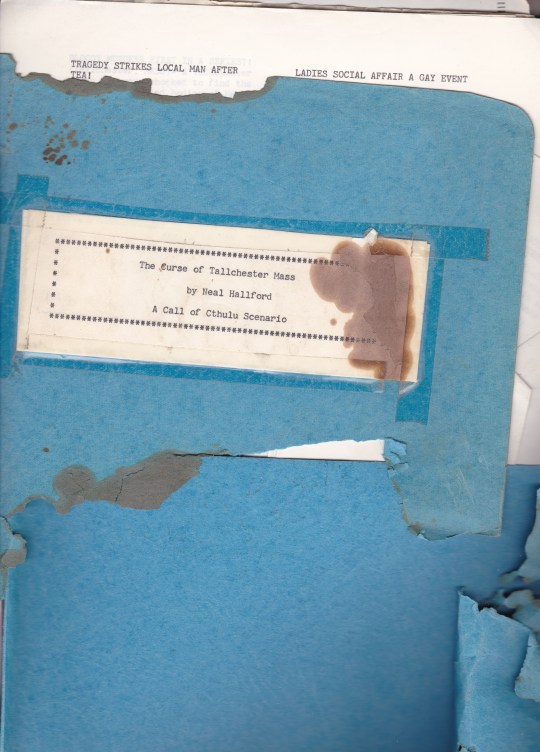
A MOLDERING, ANCIENT TOME - My notes on the Tallchester setting have not fared well over the decades, but it somehow makes the content feel moodily appropriate.
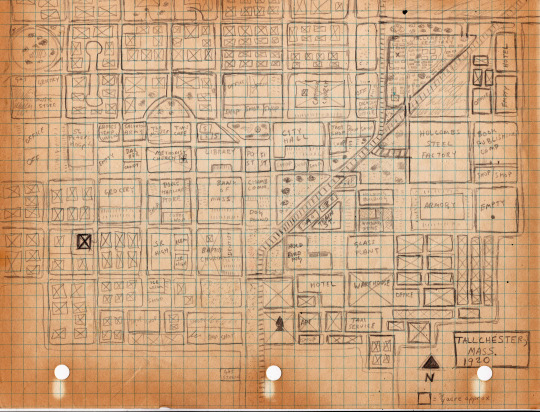
DOWNTOWN TALLCHESTER - One of several maps that I drew up as part of the Tallchester campaign setting.
As you can see, my folder for Tallchester is now a crumbling, moldy mess that would be well suited for discovery in the basement of Miskatonic University. In it I have extensive maps, character bios, and a multi-page print out from a BASIC program I’d written to randomly generate NPCs for the entire town. I had reams of handouts to give to players about events mentioned in the local newspaper, some of which were relevant to scenarios I was running, and others of which were “seeds” for adventures still to be written.
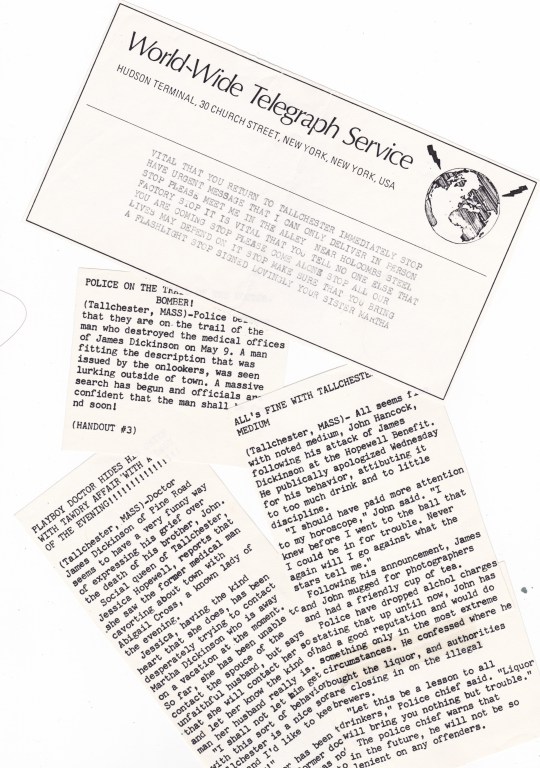
YOU LOOKIN’ FER A HANDOUT? - No Call of Cthulhu scenario is complete without a fistful of handouts, and “The Curse of Tallchester” was no exception.
I could easily have spent forever building up that fictional town, but I found that players at conventions really enjoyed it when I relocated my adventures to more familiar settings. Tulsa and its environs had been a major city during the oil boom, placing it right smack dab in the middle of Lovecraft’s 1920s. The richest oil magnate in the world at the time, J.P. Getty, lived in the Mayo Hotel. Movie stars made a point of being seen in the oil capitol, and major aeronautics companies were furiously building there. The north side of Tulsa was for a time the most prosperous black community in America, so much so that it was called “Black Wall Street” (and tragically it would also become the site of the worst race riot in America’s history). In a lot of ways it was an absolutely perfect Lovecraftian city, and all I had to do was put in the work on a source book.
Starting around 1987, I began spending a lot of time in the newspaper archives of the Tulsa Tribune, looking for any sufficiently weird headlines which might serve as the start for an Oklahoma-based Call of Cthulhu campaign. I did not come away disappointed. Between the strong streak of yellow journalism of the day and the strangeness of a world still grappling with spiritualism and science, the Tribune ended up being a gold mine of ideas. There was plenty of stuff to work with, and it was dovetailing with another project of mine to explore the ghost stories of my family and of the neighboring town of Sand Springs -- a town which originally had been named Adams before the land was bought and redeveloped by benevolent city founder, Charles Page.
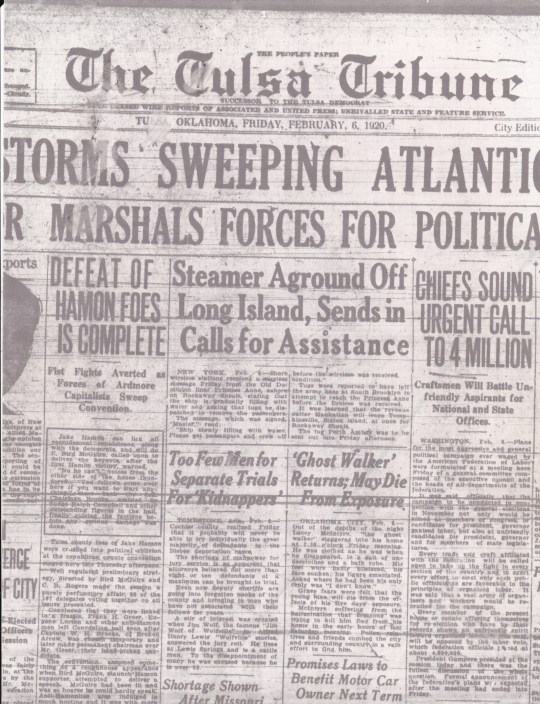
FRONT PAGE OF THE TULSA TRIBUNE, 2/6/20 - Even Tulsa’s real newspaper was covering some eldritch-level creepiness back in 1920.
Around the time that I was beginning to draw these elements into a cohesive whole, the unthinkable happened. I got a full-time, salaried job in the computer game industry doing EXACTLY what I’d been doing for fun on Tallchester and for Tulsa. I relocated to the west coast where my life became a full time dive into other worlds and other projects. As I lived and breathed new settings with very little spare time, the Tulsa Call of Cthulhu sourcebook was placed on hold and would stay there for a number of years. It wouldn’t be until a visit to the Sand Springs Cultural and Historical Museum and a discussion about the town’s folklore that I’d begin to see an opportunity to fuse both projects into a fictional setting (see my previous blog post about “A Ghost Town of My Own”). My new world would be a dark, mirror image of both Tulsa and Sand Springs and would serve as the heart of a written-for-Chaosium campaign that I wanted to name Crude Awakenings. Not only could it serve as a game framework, it would also serve well as a fictional “verse” for short stories, films, comic books and a number of other potential properties that today we’d call transmedia. Tentatively I began toying with ideas for short stories all set in this universe, with the first tale to be called The Tome set in the city’s gothic and terrifying library.
For another long spell the ideas sat until last November when I began to dust off my notes. I considered the possibilities of simply taking The Tome and turning it into a game, but after reflection, I realized that it wasn’t well suited to being a game. I needed something that would lend itself well to the format, and which wouldn’t need to be completely restructured in order to be made interactive. And so I returned to my notes on Crude Awakenings and the first scenario that I’d described for the campaign. “The Derrick” began with an oil derrick, a mysterious death, and a romp that could lead on to a globetrotting adventure of mystery, exploration, and horror.
And that’s where we begin, back where we started, standing over a dead man in the oil fields south of the eldritch city of Adams, Oklahoma.
0 notes
Text
The Derrick: Part II - Making Faces With My Friends
Once upon a time, designers were able to make games without graphics. Dungeon Masters rendered breathtaking worlds full of beauty and danger thanks to the amazing power of IMAGINEOVISION, a game engine that required only the human voice and the creativity of its players. Choose Your Own Adventure books and text-only computer games formalized the process into descriptive chunks of text between which the player had to choose, again without relying on a single pixel to aid -- or to hinder -- the player’s imagination. The power of decision-based storytelling was, and still is, one of the most compelling forms of gameplay available, but the introduction of computer graphics into the adventure genre with Mystery House forever changed the game. In order to attract and hold the attention of a modern gamer, even the best text-based adventure usually requires at least a modicum of eye-candy.
As we discussed last time, The Derrick will primarily take the form of a text adventure. In order to illuminate the people and places of Adams, Oklahoma, I’ll be creating not only the story and design for the game, but also the pixel art as well -- a first in my 27 years of game development. Because I’m not a naturally talented artist, it’s taken me several years to develop my art style, and what follows is a brief exploration of how I’ve developed the approach that I’ll be using in The Derrick.
* * *
I’ve always wanted to be an artist. I’ve envied so many of my friends who could sit down with a sketch pad and a pencil and just DRAW anything they wanted. My friend Kenneth Mayfield valiantly spent many hours trying to teach me, and he let me watch as he worked with an airbrush to create the covers of many of the Starfleet Battles strategy games. I picked up as much as I could from him, and even got to the point that I could paint halfway decent nebulae and planets, but mastery with traditional media eluded me. My hand eye co-ordination was poor, and no matter how long I worked at it, I never felt like I was making measurable progress. I might have given up on it entirely if Photoshop hadn’t come along in the early ‘90s to show me another way.
My first experiments with digital photo manipulation were typical surrealism. I cloned my dad and made him sit in his own lap. I placed myself on the cover of important magazines. I did all the silly things that most beginners did with Photoshop, and learned how to blend out scratches and obliterate wrinkles from extant photos. But not too long after I began to experiment with the tool, I began to see it not only as a way to change photos, but also to create entirely new images from scratch. I could make up for my natural deficits in hand eye co-ordination by zooming in and editing pixel by pixel, and I could undo mistakes with a simple keyclick. The program didn’t give me the talent that I didn’t have, of course, but it did provide me with the confidence that I might be able to grow and develop in a way that I hadn’t been possible with mere paint and canvas.
I’ll be the first to admit that my first fully digital “painting” was terrible. I was no better an artist than I had been in junior high, but it wasn’t a bad place from which to start.
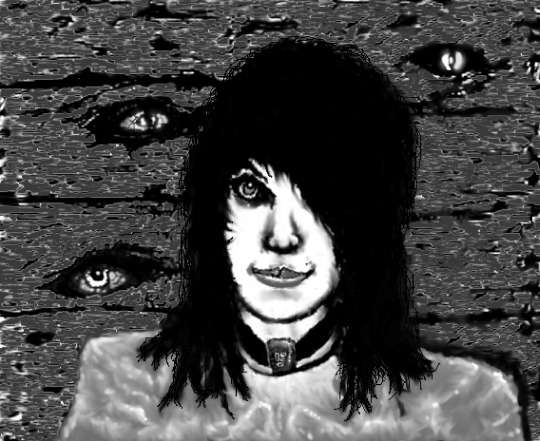
WALL OF EYES - As a whole, my first digital painting was terrible, but isolated bits of it revealed that I might be able to do things with digital painting that I hadn’t been able to master with traditional techniques.
When I got to work on my first painting, I’d had no concrete plan for what I wanted to draw. I started with the face of a cyber-punk girl and worked outward, but everything about her showed off my weaknesses as an artist. She had no structure to her face, the balance was wrong, her proportions were deformed -- from head to toe she was a nebulous mess. I’d also put zero thought into her background before starting, and as a result had to retroactively paint in a wall around her rather than painting her over it (a process that would have been a lot easier if Photoshop had had layers, but that feature wouldn’t come along for a few more years). Slowly the wall took on a kind of life of its own, becoming a rotting wood-plank fence. As the gaps and holes began to appear, my mind began to wonder what might be lurking behind them. It became evident to me that the real subjects of the painting were the eyes behind the wall rather than the girl in front of it. “Wall of Eyes” would name itself, and would later lead to two “sequel” images.
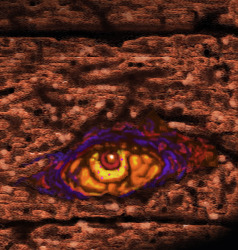
COULD SOMEBODY GET ME SOME VISINE? - Using the power of layers in Photoshop allowed me to “focus” more on fine details of the image.
With the original version of “Wall of Eyes,” I’d felt extreme hesitation at trying to fix any aspect of the image for fear of destroying what few elements I’d liked. The introduction of layers into later versions of Photoshop, however gave me not only a new way to experiment, but it also made me look at the creation process in an entirely different way.
In traditional art, it’s very customary to “build up” an image one layer at a time, painting several coats of translucent paint over each under until a net color or other effect is achieved (a core lesson I’d learned from painting nebulaes). With layers in Photoshop, I realized I could achieve the same effect without running the risk of messing up coats of paint (which would require destroying and painting over flubbed layers.) I could simply lay down different colors and textures and then alter their opacity however I desired. I could also reorder the layers in an instant, and change how they mixed with one another. Ultimately it began to feel more like the process of creating a collage, and it was freeing to realize that I could experiment without fear of messing something up.
My first use of this new feature was to return to “Wall of Eyes” and enlarge one eye that I’d found particularly menacing. Inspired by an old comic book cover, I recolored my “refocused” painting with lurid, pulp comic colors.

THE THING IN THE BOX - Taking center stage, the eye pops even more with contrasting values of heat and cold, and even greater layers of detail veining its malevolent gaze.
As I continued to toy with it and refine, I “cooled down” the fence with tones of moonlight to draw contrast with that hellish eye, and lavished more details on the eyeball itself. Using layers not only of color but also adjustments to saturation, and contrast, and other elements, I arrived at a final nightmarish image of something that none of us wants to find beneath our beds.
When I started thinking about the character portraits for The Derrick, I realized that a lot of the lessons I’d learned about painting could be used in the modification of existing materials. I could take photos of friends of mine and transform them into heavily stylized portraits that would fit the mood and style of the game I wanted to create. My portrait transformation for Delphine Mack is a fairly good example. I began with a photo of my friend Sarah Berry in vintage clothes appropriate to our 1920s setting.

The original image was black and white, and Sarah was posed against a crowded black background that had to be knocked out in order to make room for a different environment. Finding the boundaries between her dark dress and the dark background were a challenge, but it was an important step in isolating her for modification. Next, I began to hand tint the image for a slightly vintage-postcard look, and applied filters to create a paint-like “surface” to the image.
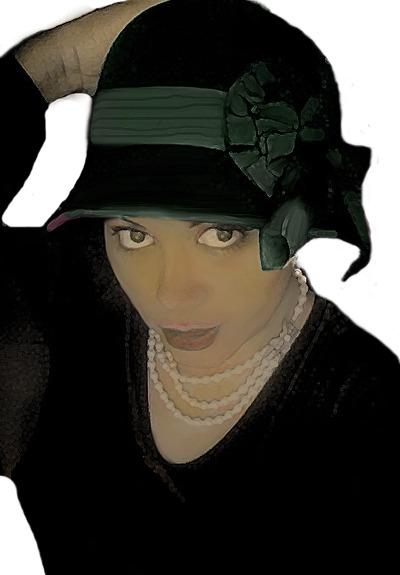
Next I turned towards the creation of a mysterious background, cloaking her in a graveyard-like fog of blue that fits the mood of the game. It felt as though she should be creeping around in graveyards or down at the riverboat dock.
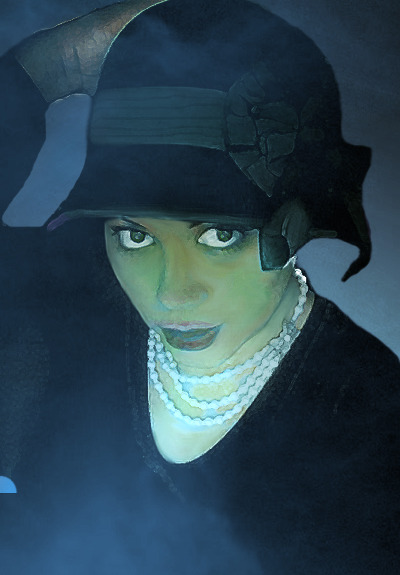
Once the fog was done, I realized that I liked it, but it seemed to compress the image into a single plane, and the color was too monochromatic. So, for a remedy, I created masks to draw a noirish slash of light across her face, while also creating contrasting bands of orange and red behind and below her for a final mysterious effect.

The irony of Delphine’s portrait creation is that I hadn’t meant for her to be a major character in The Derrick. She was intended only to be one of several non-player characters with whom the player could interact during the course of the game. But as I watched her come alive during the creation of her portrait, I began to see her as a daring and brilliant protagonist that would be very different than your usual Lovecraftian hero, and a perfect centerpiece for the tale. Many of the other characters you’ll meet in The Derrick likewise found their narratives while I was busy “painting” their faces, some of which required a great deal more compositing of elements and layers than Delphine. Phineas Book is a great example of portrait that actually required the combination of several disparate elements -- one man’s face, another person’s hands, a suit that was appropriate for the time period, and a theatrical-looking fireplace that provided the perfect backdrop. The fire itself was hand painted for final effect, as were the eyes and other smaller elements of the scene.
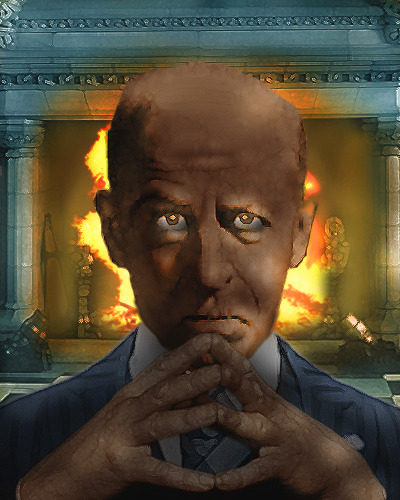
0 notes
Text
“The Case of Evil” Featured on Today’s Horror Feast Q&A
Jana and I were asked a few questions today as part of Horror Feast’s feature on our noir horror movie “The Case of Evil.” You can check out our mini-interview at https://www.facebook.com/horrorfeastqa/photos/a.106855252998133.1073741828.102084366808555/420782888272033 or watch the film on Amazon at https://www.amazon.com/Case-Evil-Merrick-McCartha/dp/B01G9I6J42
0 notes
Photo

Happy to announce that I've been asked to speak for the Power-Up Digital Games Conference that will take place online February 2nd-5th, 2017. I'll be presenting two talks and participating in one panel discussion. "Krondor Confidential: The Making of an RPG Classic" is a snapshot look at not only the making of the hit RPG Betrayal at Krondor, but also of what it was like to be a developer in the early 1990s. "Writing for the Computer Gaming Industry" will delve into the world of interactive storytelling to explain what the job entails and why story in games is just as important as it ever was. On the “Legends of RPG Panel”, I team up with Gregory A MacMartin, Greg Zeschuk, Rebecca Heineman, Richie Bisso, and Jason Fader to discuss all things role-playing. The conference will also feature talks from my buds Billy Joe Cain and David Baity. The conference is entirely online and free, so it's a great time to join us for four days of game talk! Learn more about Power-Up by visiting http://zettabytemarketing.com/pdgc/!
3 notes
·
View notes
Text
I’ll Always Have Paris
Last night, I dreamed of Paris. I think it might have been inspired by reading some of John Cutter's blog. It might also be because I was writing a dream sequence yesterday of someone being somewhere other than where they were. Not sure that there's a way to know for certain.
For years and years I've had a dream version of the city in my head that has had a specific, well-mapped out geography that is fundamentally different than the real place. In my dreams, Paris is on the coast, and there's a long red bridge that connects it to England (yes, yes, I know, the Chunnel, but this is different). Frequently I've been there with my brother Gene, though more often I've traveled there alone. I always stay in the same hotel, though I don't think it's ever had a name. There's a curving road right after you get off the bridge that always has the same shops, and I always have a happy feeling of "arrival" when I see that street.
Last night, however, the city was different. Paris now was situated on sharply rising and falling hills. Walking the streets reminded me more of walking the streets of San Francisco rather than the City of Lights. It made for a strange experience visiting places that I "knew" but now were made very different because of the altered geography.
During last night's exploration, I decided that I'd visit the daughter of a famous film composer with whom I'd been pen pal friends since childhood. This is another point of long established dream canon to me. She's never had a name. (It's strange that so many things in this mysterious place have never had names, but I guess in my dreams I've never needed them.) Despite this long friendship however, we'd never met in person. I don't know why I'd never tried to visit her in person before last night, but suddenly last night it seemed very important. I couldn't remember her address, so for a long time I simply wandered the city thinking I'd just run into her.
When randomly wandering around the city failed, I made my way to a neighborhood and a specific house. It wasn't the composer's house or his daughter's, but for some reason I knew it would be okay if I just walked in. The house was very mid-century modern, like the movies in the 50s and 60s indicated that Parisian houses should look. A jazz record was playing somewhere. Lots of hip-looking furniture and large paintings hung on the walls. A large balcony overlooked the cavernous living room. A piano sat just below it.
I could somehow tell that people were home upstairs, and I didn't want to intrude (don't ask me -- walking in the front door is fine, JUST DON’T WALK UPSTAIRS -- dream logic), so I decided to make myself known by sitting down at the piano and starting to play. In a few minutes the family members all started to drift downstairs, and they waited until I stopped playing whatever piece I was playing before they introduced themselves. It was a family of four, and very nice, happy people. Dad was, of course, a musician, and the entire family had a vaguely cartoony something about them. I asked if by any chance if they knew where I could find the composer or his daughter, and naturally they knew him, and offered to send her a note for me. I dashed it out and thanked them, and went merrily on my way. A few minutes later I worried that I hadn't included the name or address of my hotel -- neither of which I knew anyway -- but then realized that I didn't need to worry about it because she'd just know where to find me now that I was in Paris.
I headed back to my hotel, making a detour first through the water gardens, and by the baguette store. I bought flowers. Finally I got to my room and got freshened up. There was a knock at the door. I went to answer it and opened it. There was the briefest impression of a pretty blonde with a beautiful smile...and then I woke up.
For the longest moment, I had a profound feeling of disappointment. I was finally meeting this person that I'd been writing to all my life, only to have her vanish at that moment of opening the door.
I'm wondering if she'll be there the next time I visit Paris.
0 notes
Text
Last month my wife Jana launched 8thDiamond.com, a blog about her experiences and advice about the trade show industry. Yesterday she launched JanaHallford.com where she’ll blog about her personal interests and hobbies, ranging from vintage collectibles, old movies, and history.
Welcome!
I joined Pinterest in January of 2012, partly because it was the most uncontentious social media site I could find during a presidential election year. Five years, another election, and 26,000 pins later, I’m still hooked.
Pinterest wasn’t what I expected, and that’s why I’ve stayed with it. Initially I approached it as a manageable alternative to bookmarking everything I liked on the internet on my computer desktop. But the experience turned out to be so much more. It hasn’t been all about being practical (or materialistic), either. There have been many benefits, including a welcome reinforcement of my visual nature.
My college degree is in art. My emphasis was drawing and painting, but my focus was collage. On Pinterest, I’ve found a lot of joy in posting images, and in creating collections of them. I find I prefer my own boards over shared ones, as shared boards limit the ability to consider what one image looks like next to another, and to vary the images by color and composition, making an overall arrangement that continually changes and grows. In additional to the visual pleasure, my collections of topics and images have helped me delve deeper into my tastes and interests, and even caused me to reflect on where some of my interests have their roots.
My pins and occasional comments on them by others have added to the experience. For example, I’ve had a strong sense of how many objects and experiences link generations. Christmas card and Valentine images are often re-used for years. A pinner much younger than me remembered a Valentine design that looked dated when I was a child. Humble vintage kitchen items can evoke memories and great sentiment.
I’m a writer as well as an artist, and in this blog I plan to write about many subjects, often inspired by my Pinterest boards. Topics are likely to include antiques and vintage items, the arts, books and authors, classic films and classic film stars, history, holidays, customs, and etiquette, and more.
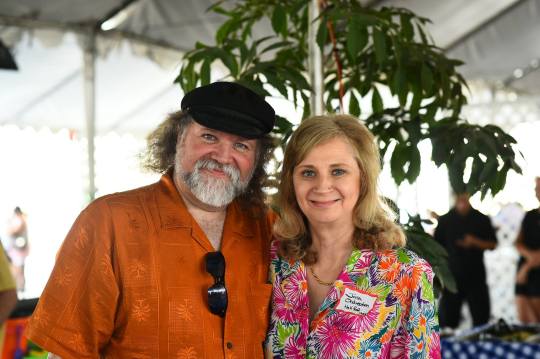
Neal & Jana, August 2016
1 note
·
View note
Text
December 20th: My Darkest Day - 20 Years Later
Twenty years ago today, I woke up knowing that I wasn't going to have a good day that day. I had no idea that it was going to turn out as badly as it did.
Jana had recently gone in for a biopsy that we'd spent months fighting to get done, and ultimately we'd had to fire her old, deeply sexist oncologist because of his insistence that the bump she was feeling under her arm was "just the end of a rib." He was treating her like she was a "hysterical woman," (which if you know Jana has never been in her nature. If anyone is the hysteric in the family, I'm the one that most resembles that sentiment.) Although I wasn't a doctor, I knew human anatomy well enough there wasn't an "end" of anything there. And if it had been a rib, ribs shouldn't grow over several months, and if they did, they needed to be checked out. After a great deal of floundering, we'd at last got it checked out, and we were scheduled to go in and get the results.
Although Jana had already been a four year breast cancer survivor when we'd married only two months earlier, I was new to this whole cancer business. The word terrified me. In my family, when someone announced they had cancer, it was usually only a matter of weeks before we'd be putting them in the ground. So when the time came to go in to the doctor's office for the results, I was already a disaster but trying to be strong for Jana's sake. In reality she was the one keeping ME sane.
The surgeon came in and sat down, getting to the point fairly quickly. The c word was said. It had come back, and it was advanced enough to require treatment. My heart and my stomach fell through the floor. Though I was supposed to be there to help her remember things the doctor said, I heard virtually nothing after the initial diagnosis and almost collapsed on the floor. To this day, I couldn't even tell you any of what the doctor said after "cancer." All I could think at the time was "oh my god, she's going to die," and it rang over, and over, and over in my head. It so was unfair. We'd only been married for two months.
Psychologists tell you about the different stages of grief. I somehow leapfrogged directly past grief, and denial, and went straight into bargaining. On the entire trip home, in my head I was saying over and over to myself, "I'll give you whatever you want, God. Take anything. Whatever you want to save her. Children. Job. My own health. Take what you want, just don't take her." I know that being the hardcore agnostic that I am that I was just talking to myself and that if God actually exists, he isn't in the bargain making business. Nonetheless, in retrospect I've been haunted for decades by those words in my head. As one of my authorial heroes Sharyn McCrumb says, some prayers the devil answers.
At home Jana and I settled in. Before the biopsy we'd been talking about having a house warming party and having some friends over to celebrate Christmas with us. We'd then decided to put everything off until we knew what was going on, worried that we wouldn't be very good hosts. Back home from the doctors', we sat on the bed and talked over everything again, realizing that we still wanted to have the party, still wanted to go on with our lives like normal. We didn't want to let cancer win, to change anything. So we started talking about plans, and talking about what we wanted to do at the party.
And that's when the phone rang.
The person on the other end of the line was very abrupt.
"May I speak to Neal Hallford?
"That's me. Who is this?"
"I'm a nurse at St. John's hospital. Your parents have been in auto accident."
At first I was processing everything as if she was speaking in a heavy accent, comprehensible only when I stopped to think about what she was saying.
"What happened?"
"Your father was experiencing chest pains, so your mother was driving him to the hospital here at St. John's when they were hit by a second vehicle. Your father has expired. "
To this day I've never forgotten the word she used. She didn't say "died" or "passed away" or anything prosaic. She was cold and absolutely clinical. Expired.
At the time my brain was just trying to process the word. I was thinking "what, my dad is a carton of milk? EXPIRED?" I couldn't believe that this stranger could deliver this news in such a horrendously brusque way.
"Your mother still doesn't know that he's dead."
I tried to wrap my mind around that. If they had been in the car together...
"Is she okay?" I managed to get in. "Is my mom still alive?"
"Yes, but they've got her in a room by herself. She's broken several ribs and she’s heavily medicated. Do you want to tell her? It would probably be best coming from a relative."
And in that moment, I failed utterly as a son. I couldn't bring myself to tell my mother on the phone that dad was dead. I couldn't even accept that he was dead myself, removed by 1,800 miles. My wife was dying. My father was gone. The torch of responsibility had been passed to me, but I was unequal to the task.
"I'm sorry," was all I could say. "Call my brother, call HER brother. I can't. I just can't."
And then I hung up.
As fate would have it, my brother Gene had already got the news. He'd come home from work to find a pair of cop cars parked in his front yard, and they'd told him what had happening. He was heading up the Turner Turnpike from Oklahoma City to Tulsa, and he'd have the thankless burden of being the eldest and telling mom that dad was gone. It was absurd and stupid. She'd been in the wreck. She'd been there. They'd brought them both in on stretchers, but no one there would tell her that her husband was dead.
An hour later the phone would ring again. It was mother, worried about ME. "Has anyone called and told you anything?"
"Yes, mom. I'm so, so sorry. I should have been the one. I knew about it first."
Halfway across the country, before Facebook, before the internet was really much of a thing, and I'd been the first person to know the impossible, that my dad was gone.
Twenty years later, that hole in my soul has never healed and has never been filled. Unquestionably the worst day of my life.
R.I.P Henry Gene Hallford SR. July 12, 1930 - December 20, 1996

FAREWELL - My last photo with my dad, taken the day of my wedding on October 5th, 1996.
0 notes
Text
Ars Technica Covers “The Con of Wrath”
Ars Technica published a nice article on Ultimate Fantasy 1982, the disastrous Star Trek convention that became known by fans as “The Con of Wrath.”
http://arstechnica.com/the-multiverse/2016/09/how-an-over-ambitious-star-trek-convention-became-the-con-of-wrath/
Our documentary of the same name also gets a nice little nod, along with the trailer for the convention that we debuted at this year’s Comic Con. #StarTrek50 #StarTrek #SupportIndieFilm #Documentary
2 notes
·
View notes
Text
“Worldbuilding & Magic Systems” Panel @ Long Beach Comic Con
Here’s the Sunday schedule for the Long Beach Comic Con where I’ll be speaking on the topic of Worldbuilding & Magic Systems. You’ll find us in the Rumble Room at 11:00 AM!

2 notes
·
View notes